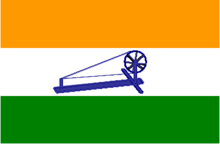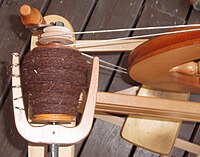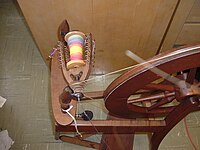Spinning wheel
Library of Congress collection

A spinning wheel is a device for spinning thread or yarn from natural or man-made fibers, where spinning is the process of twisting fibers together to create yarn.
The first improvement in spinning technology was the spinning wheel, which was invented in India between 500 and 1000 A.D.[1][2][3] It reached Europe via the Middle East in the European Middle Ages. It replaced the earlier method of hand spinning with a spindle. The first stage in mechanizing the process was to mount the spindle horizontally in bearings so that it could be rotated by a cord encircling a large, hand-driven wheel. The great wheel is an example of this type of wheel, where the fiber is held in the left hand and the wheel slowly turned with the right. Holding the fiber at an angle to the spindle produced the necessary twist.[4]
A series of improvements occurred in the 1700s and culminated in the first rotor or open end spinning mill in the United States in 1970. Until the acceptance of rotor spinning wheel, all yarns were produced by aligning fibers through drawing techniques and then twisting the fiber together. With rotor spinning, the fibers in the roving are separated, thus open end, and then wrapped and twisted as the yarn is drawn out of the rotor cup. Newer technologies that may offer even faster yarn production include friction spinning, an open-end system, an air jet, spinning a drafting system.[1]
The changes in modern spinning have had for their object; the providing of mechanical means to rotate the spindle, an automatic method of drawing out the fibers, and devices for working a large group of spindles together, at speeds before unattainable.[5]
Types of spinning wheels

Numerous types of spinning wheels exist, including the great wheel also known as walking wheel or wool wheel for rapid long-draw spinning of woolen-spun yarns; the flax wheel, which is a double-drive wheel used with a distaff for spinning linen; saxony and upright wheels, all-purpose treadle driven wheels used to spin worsted-spun yarns; and the charkha, a small, portable, hand-cranked wheel for spinning cotton and other fine, short-staple fibers.
Great wheel
One of the earlier types of spinning wheel, this wheel is hand powered. The fiber is held in the left hand and the wheel slowly turned with the right. This wheel is thus good for using the long-draw spinning technique, which requires only one active hand most of the time, thus freeing a hand to turn the wheel.

The great wheel is about the height of a person. Each revolution of the big wheel causes many revolutions of the spindle. The spindle is where the yarn is spun from, and where it is wound on once it is spun. To spin the yarn it is held far enough away from the wheel that it does not wind onto the spindle, but once a sufficient amount of yarn has been made, the spinner allows the yarn to "take up" onto the spindle, by moving decreasing the angle between the yarn and the wheel, and then starts spinning again.
One advantage of great wheels is that the tension is easy to adjust; all that is required is a step forward or backward. The wheel also has a large ratio of number of turns of the wheel to number of turns of the spindle. Some disadvantages are that one must always be standing (a fact which gave rise to the term walking wheel), and that it is less efficient than a flyer wheel because one has to stop spinning in order to wind up the yarn already made.
Charkha
A charkha (etymologically related to Chakra) was both a tool and a symbol of the Indian independence movement. Mohandas Gandhi promoted making one's own clothes (like dhoti) instead of buying European-style garments manufactured in Britain from Indian raw materials; and to avoid becoming westernized. The charkha works similarly to the great wheel, with a drive wheel being turned by hand, while the yarn is spun off the tip of the spindle. Spinning must stop in order to wind on the yarn.
Treadle Wheel
This type of wheel is powered by the spinner's foot rather than the hand. There are many variations, but the basic idea is the same. The spinner sits and pumps a foot treadle that turns the drive wheel via a crankshaft and a connecting rod. This leaves both hands free for drafting the fibers. The old-fashioned "spike" spindle is not a common feature of the treadle wheel. This type of wheel employs, rather, a flyer and bobbin system which both twists yarn and winds it onto a spool simultaneously. In some modern versions, there are often two treadles, so that the feet alternate. Two treadles cause the wheel turns at a more even speed, and the spinners to not get only one tired leg.
Double drive

The flax wheel is a good example of a double drive wheel. The double drive wheel is named after its drive band, which goes around the spinning wheel twice. The drive band turns the flyer, which is the horse-shoe shaped piece of wood surrounding the bobbin, as well as the bobbin. The bobbin has a smaller radius than the flyer, thus the drive band tries to turn it faster. When the yarn is being wound on the bobbin, the bobbin goes faster and winds yarn on.
The drive band on the double drive wheel is generally made from a no-stretch yarn; candlewick is also used.
Single drive
A single drive wheel has one drive band, in contrast to the double drive wheel, where the drive band goes around the wheel two times.

Most of the drive bands for single drive wheels are made from synthetic cord, which is elastic and does not slip easily on the wheel.
Where the double drive works by attempting to turn the bobbin faster than the flyer, the single drive works by slowing the bobbin down with a brake band. While the spinner is making new yarn, the bobbin and the flyer turn in unison, but when the spinner wants to wind the yarn onto the bobbin, the bobbin slows down and thus the yarn winds on. The bobbin slows down because of the brake band, which is generally a slick cotton cord that goes over one end of the bobbin. The tighter the brake band is, the more pull on the yarn, because the more friction the bobbin has to overcome in order to turn in sync with the flyer.
Castle style

When the spindle and flyer are located above the wheel, rather than off to one side, the wheel is said to be a castle wheel. This type of wheel is often more compact, thus easier to store. Some castle wheels are even made to fold up small enough that they fit in carry-on luggage at the airport. Castle wheels almost always have two foot treadles, though one treadle is often an option.
Notes
- ^ a b Cotton: Origin, History, Technology, and Production By C. Wayne Smith, Joe Tom Cothren. Page viii. Published 1999. John Wiley and Sons. Technology & Industrial Arts. 864 pages. ISBN 0471180459
- ^ The Columbia Encyclopedia, Sixth Edition. Columbia University Press
- ^ 1994-2007 Britannica Concise Encyclopedia.
- ^ Spinning wheel. (2007). In Encyclopædia Britannica. Retrieved April 7, 2007, from Encyclopedia Britannica Online.
- ^ Encyclopedia Britannica Eleventh Edition article on spinning.
References
- Cotton: Origin, History, Technology, and Production By C. Wayne Smith, Joe Tom Cothren. Published 1999. John Wiley and Sons. Technology & Industrial Arts. 864 pages. ISBN 0471180459
